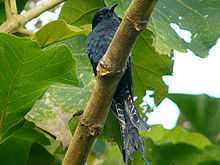Fork-tailed drongo-cuckoo
| Fork-tailed drongo-cuckoo | |
|---|---|
 | |
| Juvenile S. dicruroides | |
| Conservation status | |
| Scientific classification | |
| Kingdom: | Animalia |
| Phylum: | Chordata |
| Class: | Aves |
| Order: | Cuculiformes |
| Family: | Cuculidae |
| Genus: | Surniculus |
| Species: | S. dicruroides |
| Binomial name | |
| Surniculus dicruroides (Hodgson, 1839) | |
The fork-tailed drongo-cuckoo (Surniculus dicruroides) is a species of cuckoo that resembles a black drongo. It is found resident mainly in peninsular India in hill forests although some specimens are known from the Himalayan foothills. It can be easily distinguished by its straight beak and the white barred vent. It has a deeply forked tail often having a white spot on the back of the head. The song has been described as a series of 5 or 6 whistling "pip-pip-pip-pip-pip-" notes rising in pitch with each "pip".[2]
It is a brood parasite on small babblers. It is not known how or whether the drongo-like appearance benefits this species but it is suspected that it aids in brood-parasitism just as hawk-cuckoos appear like hawks.[3]
Some recent work suggested that the species was conspecific with the square-tailed drongo-cuckoo and together known as the Asian drongo-cuckoo, but should be split based on call and morphological differences:[2][4]
References
- ↑ "Surniculus dicruroides". International Union for Conservation of Nature and Natural Resources. Retrieved 2014-12-31.
- ↑ 2.0 2.1 Rasmussen, P. C. & Anderton, J. C. 2005 Birds of South Asia. The Ripley Guide. Smithsonian and Lynx Edicions
- ↑ Davies NB & Welbergen JA (2008). "Cuckoo-hawk mimicry? An experimental test" (PDF). Proc. Biol. Sci. 275 (1644): 1817–1822. doi:10.1098/rspb.2008.0331. PMC 2587796. PMID 18467298.
- ↑ Fu-Min, Lei & Robert B. Payne (2002) Territorial songs of the drongo cuckoo complex (Surniculus lugubris & S. velutinus). The Raffles Bulletin of Zoology 50(1):205-213 PDF
